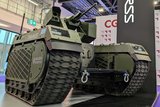MUOS software waveform delivered to US Navy
Lockheed Martin announced on 8 January that it has completed and delivered the software waveform for the US Navy's Mobile User Objective System (MUOS). A next-generation narrowband tactical satellite communications system, MUOS will provide significantly improved and secure communications capabilities, including simultaneous voice, video and data, for mobile and remote users.
The new waveform will enable military satellite communications terminal providers to deploy equipment that takes full advantage of enhanced MUOS capabilities. MUOS satellites are equipped with a Wideband Code Division Multiple Access (WCDMA) payload that provides a 16-fold increase in transmission throughput over the current Ultra High Frequency (UHF) satellite system. Lockheed Martin tailored a previously commercial waveform to be used with the new WCDMA payload.
The US government made the waveform available for military satellite communications terminal providers through the Joint Tactical Networking Center (JTNC) Information Repository, and contractors can now integrate the waveform into their MUOS-compatible terminals to provide WCDMA capabilities for users.
Each MUOS satellite also includes a legacy UHF payload that is fully compatible with the current UHF follow-on system and legacy terminals. This dual-payload design ensures a smooth transition to the cutting-edge WCDMA technology while the legacy system is phased out.
The first MUOS satellite and associated ground system already provide initial on-orbit capability. After the second MUOS satellite is launched in July 2013 and completes on-orbit testing and check-out with the MUOS ground system and a HMS Manpack terminal certified with the MUOS waveform, the system will provide full WCDMA capability to users.
Lockheed Martin is currently under contract to deliver five MUOS satellites and the associated ground system to the US Navy.
More from Digital Battlespace
-
![Babcock nears first customer for Nomad AI translation tool]()
Babcock nears first customer for Nomad AI translation tool
Nomad can provide militaries with real-time intelligence, saving critical time on the battlefield.
-
![AUSA 2025: Israel’s Asio Technologies to supply hundreds of improved Taurus tactical systems]()
AUSA 2025: Israel’s Asio Technologies to supply hundreds of improved Taurus tactical systems
Taurus operates alongside the Israel Defense Forces’ Orion system which supports mission management across tens of thousands of manoeuvring forces, from squad leaders to battalion commanders.
-
![AUSA 2025: Kopin pushes micro-LED plans as China moves faster]()
AUSA 2025: Kopin pushes micro-LED plans as China moves faster
The plan for the new displays follows fresh investment in Kopin’s European facilities by Theon and an order for head-up displays in fielded aircraft, with funding from the US Department of Defense.
-
![AUSA 2025: Persistent Systems to complete its largest order by year’s end]()
AUSA 2025: Persistent Systems to complete its largest order by year’s end
Persistent Systems received its largest ever single order for its MPU5 devices and other systems earlier this month and has already delivered the 50 units to the US Army’s 4th Infantry Division.
-
![Aselsan brings in dozens of companies and systems under the Steel Dome umbrella]()
Aselsan brings in dozens of companies and systems under the Steel Dome umbrella
Turkey has joined the family of countries attempting to establish a multilayered air defence system with government approval in August 2024 for the effort landed by Aselsan. Dubbed Steel Dome, the programme joins Israel’s Iron Dome, the US Golden Dome, India’s Mission Sudarshan Chakra and South Korea’s low-altitude missile defence system.
-
![DSEI 2025: MARSS unveils new agnostic multidomain C4 system]()
DSEI 2025: MARSS unveils new agnostic multidomain C4 system
MARSS’ NiDAR system has been deployed using sensors from static platforms to provide detection and protection for static sights, such as critical infrastructure, ports and military bases.

























